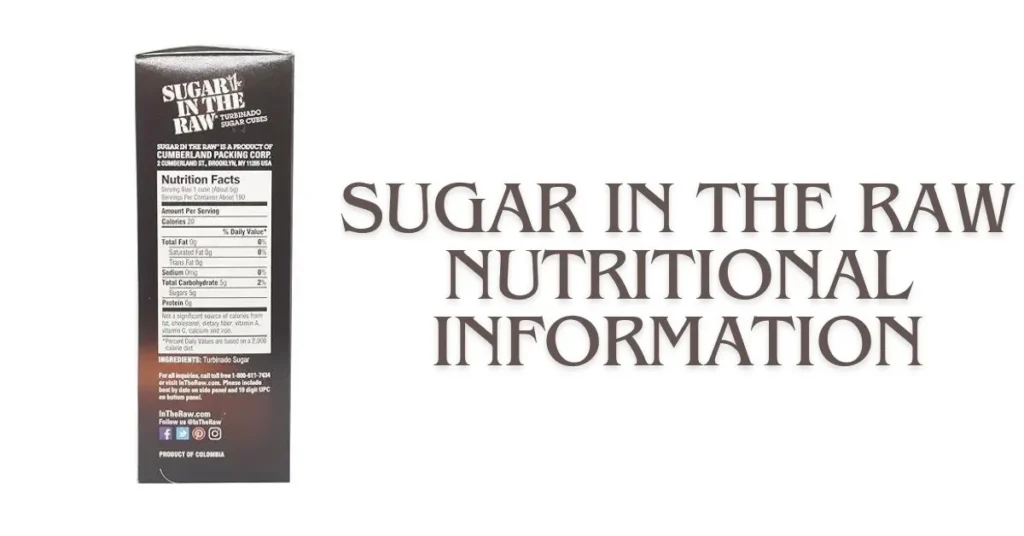Sugar is a common ingredient in many households, used to sweeten everything from morning coffee to baked goods. Among the various types of sugar available, “Sugar in the Raw” stands out for its distinct flavor and less processed nature. But what exactly is the nutritional profile of this popular sweetener? In this article, we’ll explore Sugar in the Raw nutritional information to help you make informed choices about its use in your diet.
What Is Sugar in the Raw?
Before diving into the nutritional facts, let’s understand what Sugar in the Raw actually is. Sugar in the Raw is a brand of turbinado sugar, which is a type of raw sugar that is less refined than white granulated sugar. It retains some of the natural molasses, giving it a light brown color and a richer, more complex flavor. The larger crystals and subtle caramel taste make it a favorite for coffee, tea, and sprinkling on baked goods.
Unlike white sugar, which undergoes extensive processing and bleaching, Sugar in the Raw undergoes minimal processing. This results in a product that is closer to its natural state, which many people believe is a healthier option.
Nutritional Profile: Calories and Carbs
When examining Sugar in the Raw nutritional information, the key components to consider are calories and carbohydrates. A typical serving size is one teaspoon, which contains approximately 4 grams of sugar. This serving provides about 15 calories, all of which come from carbohydrates.
The carbohydrate content in Sugar in the Raw is identical to that of regular sugar, with one teaspoon containing roughly 4 grams of carbs. These carbohydrates are primarily simple sugars, which can quickly raise blood glucose levels. Therefore, individuals monitoring their carbohydrate intake, such as those with diabetes, should use Sugar in the Raw in moderation.
Vitamins and Minerals: Is There Any Nutritional Value?
One might wonder if Sugar in the Raw offers any additional nutritional benefits compared to regular white sugar. While it does retain trace amounts of minerals from the sugarcane, these quantities are minimal. You’ll find small amounts of calcium, potassium, iron, and magnesium, but not enough to significantly impact your daily nutrient intake.
The primary appeal of Sugar in the Raw lies in its flavor and less processed nature rather than its nutritional content. It’s important to recognize that, despite its more natural state, it remains a source of empty calories—providing energy without essential nutrients.
Comparing Sugar in the Raw to Other Sugars:
How does Sugar in the Raw compare to other types of sugars like white sugar, brown sugar, and other raw sugars? In terms of calories and carbohydrates, all these sugars are quite similar. Each type contains around 15-20 calories and 4-5 grams of carbs per teaspoon.
However, the differences lie in flavor, texture, and processing. Brown sugar, for instance, has molasses added back into it after processing, giving it a richer flavor but still undergoing more refinement than raw sugar. White sugar is the most processed and has no molasses content. Raw sugars, including turbinado and demerara, are minimally processed and retain some natural molasses, offering a more complex flavor profile.
Health Implications: Is Sugar in the Raw a Healthier Option?
Is Sugar in the Raw healthier than other sugars? While it is less processed and retains trace minerals, it is still sugar and should be consumed in moderation. Excessive sugar intake, regardless of the type, can lead to various health issues such as weight gain, tooth decay, and increased risk of chronic diseases like diabetes and heart disease.
The American Heart Association recommends limiting added sugars to no more than 6 teaspoons (about 24 grams) per day for women and 9 teaspoons (about 36 grams) per day for men. Keeping within these guidelines is crucial for maintaining good health, whether you choose Sugar in the Raw or another type of sugar.
Using Sugar in the Raw in Your Diet:
Incorporating Sugar in the Raw into your diet can be done thoughtfully. Its unique flavor makes it a great addition to coffee, tea, and baked goods. You can also use it as a topping for oatmeal, yogurt, and fresh fruit to add a touch of sweetness without overwhelming the natural flavors.
When baking, you might notice that Sugar in the Raw doesn’t dissolve as easily as white sugar due to its larger crystals. This can be an advantage in recipes where a bit of crunch is desirable, such as in cookies or as a finishing touch on muffins. For recipes requiring a smoother texture, you may need to process the sugar in a blender or food processor to break down the crystals.
Sweetening Smart: Moderation is Key
Regardless of the type of sugar you prefer, moderation is essential. The key to enjoying sugar, including Sugar in the Raw, is to use it sparingly and as part of a balanced diet. Pairing sugary treats with high-fiber foods, proteins, and healthy fats can help mitigate blood sugar spikes and provide a more sustained energy release.
Additionally, exploring natural sweeteners like honey, maple syrup, or agave nectar can offer variety and additional flavors. Each of these sweeteners has its own unique nutritional profile and can be used interchangeably in many recipes to keep things interesting and flavorful.
Conclusion: Understanding Sugar in the Raw
Sugar in the Raw offers a less processed alternative to regular white sugar with a unique flavor that many people enjoy. When examining Sugar in the Raw nutritional information, it’s clear that while it retains some trace minerals, it still contains calories and carbohydrates similar to other types of sugar.
For those who prefer a more natural and flavorful sweetener, Sugar in the Raw can be a great addition to the pantry. However, it’s important to use it in moderation as part of a balanced diet. By being mindful of your sugar intake and exploring various sweetening options, you can enjoy the sweetness of life without compromising your health. Cheers to making informed and delicious choices.







